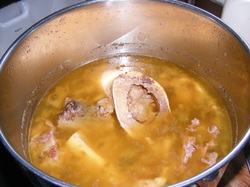 Every time we process a cow, pig or chicken, along with all the popular cuts of meat, we get loads of bones and offal. Here’s a way to put it into perspective: of the meat we just got back from one of our cows, weight-wise, almost 20% was bones. Compare that to 1.5% tenderloin steaks, or 6% short ribs and 3% liver. Did you get that? If you are eating nose to tail, you should be eating TWICE as much liver as beef tenderloin. Around here, we value every single part of each animal we raise, so we try to find a use for all of the bones and offal (the nutritious innards that are rarely eaten today, like liver, heart and kidneys). The good news is, the price of each cut usually reflects these proportions as well: Our tenderloin steaks are $17/lb, but we’re selling bones for just $1/lb. The frugal shopper will recognize the value in the bones! Here at Maple View Farm, we make bone broth as often as we have bones sitting around. You’ll hear me preaching the benefits of bone broth: from improving gut health and boosting your immune system to boosting the body’s supply of nutrients that help you have great skin and hair. So it’s not surprising that lots of people ask for recipes. I’ll put a couple of recipes here to get you started, but the first direction is: just do it! The ingredients for broth are simply 1. (any kind of) bones and 2. Water. Start with bones you know something about. Talk to you farmer, and ideally – meet your meat. How did the animal live? What did it eat? This all adds up to what kind of nutrients you get out of your bones. And what kind of farming practices you want to support. (Read my blog post about Sad Cows here.) Every time I make bone broth I do it differently. I love taking time to roast the bones in the oven, then transfer them to the stock pot, cover them with water and simmer all day. Making broth during the summer is great because I throw in the ends of veggies and herbs from the garden, increasing the nutrient value of the stock. But if I have neither the veggies nor the time, it doesn’t mean that I don’t make stock. I still can get all the goodness out of the bones, and use aromatics later when I use the broth for cooking. So head over to your local farmer, grab a bag of bones and get started. You’ve got everything to gain. Here’s a fancy recipe from Emeril Lagasse that will yield a beef broth so delicious it will be a treat to just sip on its own. BONE BROTH Ingredients 7 pounds beef bones, sawed into 2-inch pieces 1 (6-ounce) can tomato paste 2 cups chopped onions 1 cup chopped celery 1 cup chopped carrots 2 cups claret wine 20 peppercorns 5 garlic cloves, peeled 5 bay leaves 1 teaspoon dried leaf thyme 1 1/2 gallons water Directions Preheat the oven to 400 degrees F. Place the bones on a roasting pan and roast for 1 hour. Remove from the oven and brush with the tomato paste. Lay the vegetables over the bones. Return to the oven and roast for 30 minutes. Place the pan on the stove and deglaze with the wine, scraping the bottom of the pan for browned particles. Put this mixture in a large stock pot. Add the peppercorns, garlic, and herbs. Season with salt. Bring the liquid up to a boil and reduce to a simmer. Cook for 4 hours. Remove from the heat and skim off any fat that has risen to the surface. Strain the liquid and discard the bones. And here’s my recipe that even the novice cook can manage: 4 quarts of water 1.5- 2 lbs of beef knuckle bones or marrow bones Cloves from 1 whole head of fresh garlic, peeled & smashed Any veggies you have especially aromatics like carrots, onions, celery. But I’ve included older leafy greens like kale or collards that need to be used up out of the fridge. They just add to the nutrients Add salt to taste if you like, or leave it out completely Directions Place all ingredients in a 6 quart crock pot and set the heat to HIGH. Bring the stock to a boil (or as hot as your crock pot gets), then reduce the heat setting to LOW. Let the stock to cook for a minimum of 8 hours and up to 24 hours. The longer it cooks, the better. Take the lid off the crock pot for the last hour or two to let the stock reduce. Turn off the crockpot and allow the stock to cool. Strain the stock through a fine mesh metal strainer and feed all that to your chickens. Freeze the cooled stock – some in 2 cup portions and some in ice cube portions. Double, triple, or quadruple this recipe depending on the amount of bones you have. Sometimes I’ll use my lobster pot instead of a stock or crock pot. NOTE: When fully cooled, your bone broth will be thick and gelatinous. Don't worry! That's what makes it so good for you.
4 Comments
1/24/2014 02:43:48 am
Just made broth this week. My neighbor gave me her bones from the 4H grown calves that we each purchased last spring. She wanted them out of her freezer. It will make great soup, probably real soon if this cold weather keeps up.
Reply
3/10/2022 03:08:11 am
This is a very informative—edifying article to all. Thanks a lot! Continue to post!
Reply
Leave a Reply. |
AuthorA blog about farming and food. Kate Bogli owns and operates Maple View Farm, raising livestock and growing veggies, with her husband Jason. The farm has been in his family for 65 years. Archives
October 2021
Categories
All
|
 RSS Feed
RSS Feed